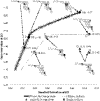Optimal portfolio design to reduce climate-related conservation uncertainty in the Prairie Pothole Region
- PMID: 22451914
- PMCID: PMC3340047
- DOI: 10.1073/pnas.1114653109
Optimal portfolio design to reduce climate-related conservation uncertainty in the Prairie Pothole Region
Abstract
Climate change is likely to alter the spatial distributions of species and habitat types but the nature of such change is uncertain. Thus, climate change makes it difficult to implement standard conservation planning paradigms. Previous work has suggested some approaches to cope with such uncertainty but has not harnessed all of the benefits of risk diversification. We adapt Modern Portfolio Theory (MPT) to optimal spatial targeting of conservation activity, using wetland habitat conservation in the Prairie Pothole Region (PPR) as an example. This approach finds the allocations of conservation activity among subregions of the planning area that maximize the expected conservation returns for a given level of uncertainty or minimize uncertainty for a given expected level of returns. We find that using MPT instead of simple diversification in the PPR can achieve a value of the conservation objective per dollar spent that is 15% higher for the same level of risk. MPT-based portfolios can also have 21% less uncertainty over benefits or 6% greater expected benefits than the current portfolio of PPR conservation. Total benefits from conservation investment are higher if returns are defined in terms of benefit-cost ratios rather than benefits alone. MPT-guided diversification can work to reduce the climate-change-induced uncertainty of future ecosystem-service benefits from many land policy and investment initiatives, especially when outcomes are negatively correlated between subregions of a planning area.
Conflict of interest statement
The authors declare no conflict of interest.
Figures



Comment in
-
Improving biodiversity conservation through modern portfolio theory.Proc Natl Acad Sci U S A. 2012 Apr 24;109(17):6360-1. doi: 10.1073/pnas.1205114109. Epub 2012 Apr 18. Proc Natl Acad Sci U S A. 2012. PMID: 22517756 Free PMC article. No abstract available.
-
Improving risk assessment for biodiversity conservation.Proc Natl Acad Sci U S A. 2012 Aug 28;109(35):E2304; author reply E2305. doi: 10.1073/pnas.1207485109. Epub 2012 Jul 25. Proc Natl Acad Sci U S A. 2012. PMID: 22837394 Free PMC article. No abstract available.
References
-
- Thomas CD, et al. Extinction risk from climate change. Nature. 2004;427:145–148. - PubMed
-
- Walther G-R, et al. Ecological responses to recent climate change. Nature. 2002;416:389–395. - PubMed
-
- Mawdsley JR, O'Malley R, Ojima DS. A review of climate-change adaptation strategies for wildlife management and biodiversity conservation. Conserv Biol. 2009;23:1080–1089. - PubMed
-
- Heller NE, Zavaleta ES. Biodiversity management in the face of climate change: A review of 22 years of recommendations. Biol Conserv. 2009;142:14–32.
-
- Ando A, Camm J, Polasky S, Solow A. Species distributions, land values, and efficient conservation. Science. 1998;279:2126–2128. - PubMed
Publication types
MeSH terms
LinkOut - more resources
Full Text Sources

